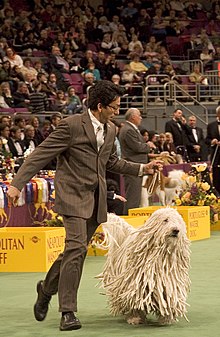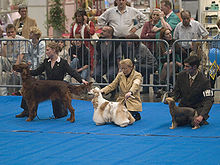Dog show
A dog exhibition (also a pedigree dog exhibition ) is an event organized by a breed association for pedigree dogs to showcase its success in breeding. Dogs of different breeds are presented at dog shows, otherwise the term breed show or club show is common.
The focus of the exhibition is on the breeding shows of the different breeds , which are judged on the basis of their respective breed standards . At larger exhibitions, breed associations of individual breeds usually present themselves with information stands and suppliers of dog accessories with sales stands. There is usually a supporting program for visitors to the exhibition.
history
The first show of pedigree dogs took place on June 28 and 29, 1859 in Newcastle upon Tyne in Great Britain. At the first exhibition in Germany, from July 14th to 20th, 1863 in Hamburg, 453 dogs were shown.
Measured by the number of dogs on display , the Crufts organized by the KC is the largest dog show in the world. The oldest exhibition still held today is the Westminster Kennel Club Dog Show in New York City , organized under AKC rules , which has been held since 1877. The largest exhibition within the FCI is the World Dog Show . The best dog of each breed receives the title of world winner in the latter .
execution
The largest exhibitions in German-speaking countries are organized by the member associations of the FCI . There are two types of exhibitions within the FCI, which differ in terms of the awards given:
- National dog shows
- International dog shows
At national shows, the CAC (Certificat d'Aptitude au Championnat, entitlement to the national beauty champion) is awarded by the respective breeding associations. At international shows according to the FCI regulations, in addition to the CAC, the CACIB ( Certificat d'Aptitude au Championnat International de Beauté , the entitlement to the International Beauty Champion) is awarded. These shows are known as the "International Dog Show with CACIB of the FCI".
In the breeding shows of the respective breeds, breeding judges evaluate the dogs presented on the basis of breed standards and association-specific guidelines. Grades, titles and championships are awarded. The evaluations at the breeding shows form a basis for the selection of dogs for breeding, with some breeding associations the breeding approval takes place immediately ( approval ).
Since January 1, 2009, exhibition regulations have been in effect for temporary exhibitions of the VDH , which replaced the previous breeding show regulations; on April 15, 2012, the exhibition regulations were adopted, which have been in force since July 27, 2012.
Shape values
To assess the dogs on the basis of the breed standard, the judge writes a written criticism for each dog exhibited, which describes its strengths and weaknesses and which also includes the form rating .
The following form values are possible:
- Excellent - for dogs that are highly standard
- Very good - for dogs with some minor flaws
- Good - for dogs with major flaws
- Sufficient - for dogs corresponding to the breed type that have significant defects
- Disqualified - for dogs not corresponding to the breed type, aggressive dogs, dogs with certain hereditary defects and dogs with disqualifying characteristics according to the respective breed standard
- Without evaluation - for dogs that cannot be judged due to their behavior or other circumstances
Deviating from these grades, the VDH for dogs in the youngest class (age 6–9 months) gives the form grades promising , promising and not very promising . These are also awarded at special pedigree dog shows in the puppy class / baby class (4–6 months), in the veteran class (from 8 years) no marks are given.
Judging process
The dogs of each breed are judged separately according to gender and divided into classes. The number of classes and their names are country and breed specific. Within each class, the four best dogs are placed one behind the other, provided they have been rated at least "very good". The regulations in which classes a CAC can be awarded also differ from country to country.
The best dogs of each class appear at the end of the regular judging to determine the best dog of the breed ("Best of Breed", BOB) and the best dog of the opposite sex ("Best of Opposite Sex", BOS) and at international shows in addition to Award of the CACIB against each other. The judge can award a maximum of one CACIB and one reserve CACIB per gender. However, he is not obliged to award a CAC or CACIB.
After the regular judging according to FCI groups , the best dogs of each breed compete against each other separately to determine the best dog in the group, the "Best of Group". The winners of these group competitions again compete to determine the best dog in the show, the “Best in Show”.
National and international championships
As soon as a dog in a country has received a number of CACs specified by the national umbrella organization and meets the conditions specified by the responsible breed club, it is awarded the title of “National Beauty Champion” of the respective country upon application. In order to acquire the title “International Beauty Champion of the FCI” (CIB Champion International de Beaute ), which is directly awarded by the FCI , a dog must win four CACIBs under at least three different judges in at least three different countries affiliated with the FCI, with between the first and the last CACIB must be at least one year and one day. If there is a working test for the dog breed , the dog must also have passed it in order to be awarded the international championship title. If such a dog has not passed or passed the working test, it can acquire the title “International Show Champion” (CIE Champion International d'Exposition ).
criticism
Critics of dog shows complain that dog shows unilaterally promote the selection for certain characteristics defined in the breed standard that can be harmful to the affected dogs (e.g. ectropion or brachycephaly ), which in turn can create incentives for torture breeding . It is also possible that successful show dogs are increasingly used in breeding, even though they pass on hereditary diseases , since some breeders are more important about show success than breeding hygiene. Such grievances are discussed in the documentary Pedigree Dogs Exposed , among others .
In response to such criticism, in 2012 the British Kennel Club introduced independent veterinary examinations of what the judges considered the best dog of each of these breeds for (initially) 15 breeds designated as high profile breeds. Dogs that fail this test will not be awarded the BOB. The FCI has not yet introduced any such investigations; The President of the AKC Dennis Sprung has spoken out in a statement against veterinary examinations. In March 2012 the UKC announced a review of all breed standards for animal welfare issues.
Individual evidence
- ↑ Hans-Joachim Swarovsky (Ed.): BI-Lexikon Hundehaltung, Leipzig 1988, ISBN 3-323-00186-9
- ↑ Show regulations of the FCI (pdf; 246 kB)
- ↑ Association for the German dog industry: Annual report for the year 2009. P. 28 ( online ; PDF; 5.5 MB)
- ↑ a b VDH: Exhibition Regulations (PDF; 185 kB) as of April 15, 2012. (In force since July 27, 2012) Accessed on December 17, 2012
- ↑ FCI regulations for the international championship (CACIB) (PDF; 728 kB)
- ↑ The Kennel Club Dog Health Group Annual Report 2012 (PDF; 638 kB) on the Kennel Club website (accessed August 12, 2018)
- ↑ Veterinary Health Checks for Breeds listed On Breed Watch as Category Three. Exhibitor Information (PDF; 1398 kB) on the Kennel Club website (accessed on August 12, 2018)
- ^ Statement by Dennis Sprung (accessed on March 16, 2012)
- ↑ UKC Announces Major Revisions To Its Breed Standards ( page no longer available , search in web archives ) Info: The link was automatically marked as defective. Please check the link according to the instructions and then remove this notice. from the UKC website, accessed March 30, 2012
Web links
- FCI regulations for the international championship (CACIB) (PDF; 728 kB)
- Rules for show judges of the FCI (PDF; 204 kB)
- Show regulations of the FCI , valid since January 1st, 2013, with changes as of January 1st, 2014 (PDF; 246 kB)



